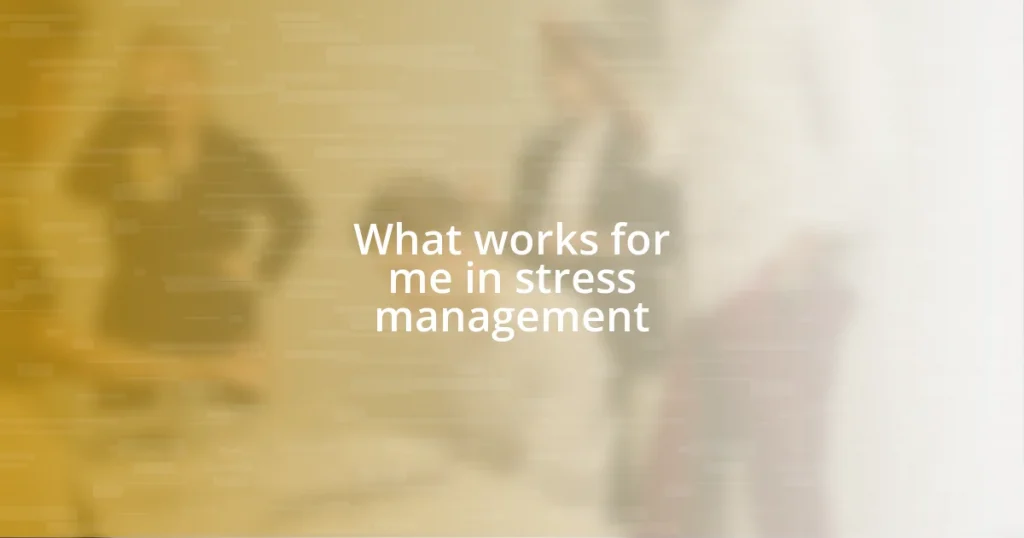Key takeaways:
- Understanding stress and its effects is crucial for health, with chronic stress linked to serious conditions like heart disease and depression.
- Incorporating stress management techniques such as mindfulness, physical activity, and journaling can enhance mental clarity, emotional health, and overall well-being.
- Creating a supportive environment—through both physical surroundings and nurturing relationships—plays a vital role in effective stress management. Setting boundaries is also essential for maintaining mental health.

Understanding Stress and Its Effects
Stress is a natural response our bodies have to challenges or demands, often experienced before big events like presentations or exams. I remember one time before a major work presentation; my heart raced and my palms were sweaty, a classic symptom of the fight-or-flight response. It’s fascinating how our bodies can react before our minds even process the situation!
The effects of stress can manifest in various ways—physically, emotionally, and mentally. For instance, I often notice that during particularly stressful weeks, I wake up feeling tired or find myself battling anxiety for no apparent reason. Have you ever felt that heavy weight in your chest when your to-do list seems never-ending? It’s like a cloud hanging over you, affecting not only your focus but also your overall mood.
Over time, chronic stress can lead to serious health issues, including heart disease, depression, and weakened immune function. A few years back, I neglected my stress levels, thinking I could power through—only to end up getting sick often. It’s a harsh reminder that understanding stress isn’t just about recognizing it; it’s about knowing how to manage it before it spirals out of control.

Importance of Stress Management Techniques
Stress management techniques are essential for maintaining our well-being and performance. When I started incorporating practices like breathwork and mindfulness into my daily routine, I found myself better equipped to handle daily stressors. This shift not only boosted my productivity but also enhanced my mood, allowing me to face challenges with a clearer mind.
Here are some key reasons why stress management techniques matter:
- Enhance Resilience: They help build a buffer against the pressures of daily life, making it easier to bounce back from setbacks.
- Improve Mental Clarity: Practicing stress relief can significantly boost focus and decision-making.
- Promote Emotional Health: These techniques foster greater emotional regulation, helping to reduce feelings of anxiety and overwhelm.
- Physical Well-being: Engaging in stress management can lead to lower blood pressure and better immune function, as I experienced after committing to regular meditation after a particularly stressful work project.
- Foster Better Relationships: Reducing stress can improve how we interact with those around us, helping to mitigate tension and promoting more meaningful connections.
I remember one particularly hectic week at work when I decided to take short breaks to practice deep breathing. While at first it felt like just another task on my list, the difference was immediate—I returned to my work feeling refreshed and ready to tackle the next challenge.

Practical Strategies for Stress Relief
Finding effective stress relief strategies is like discovering a personal toolkit that you can always rely on. One approach that has worked wonders for me is incorporating regular physical activity into my routine. Whether it’s a brisk walk during lunch or a quick jog in the evening, I find that getting my body moving alleviates stress significantly. There’s something about the rhythm of my footsteps and the fresh air that clears my mind and boosts my mood.
Another go-to strategy is journaling. Honestly, it’s quite therapeutic! I make it a point to jot down my thoughts, feelings, or even a list of things I’m grateful for. When I write, I feel lighter, as if the words absorb some of that built-up tension. Have you ever experienced the relief of getting those swirling thoughts onto paper? For me, it transforms my worries into manageable pieces, helping me gain perspective.
Finally, I can’t emphasize enough the benefits of connecting with loved ones. A simple phone call or a cozy chat over coffee has a remarkable ability to ground me. I remember a time when I was overwhelmed with deadlines; reaching out to a close friend not only lifted my spirits but also reminded me that I wasn’t alone in tackling life’s challenges. It’s surprising how a shared laugh or understanding nod can lift a heavy burden.
| Strategy | Description |
|---|---|
| Physical Activity | Engaging in exercise can release endorphins, enhancing mood and reducing stress. |
| Journaling | Writing down thoughts helps process emotions and gain clarity on stressors. |
| Connecting with Loved Ones | Talking with friends or family provides support and perspective, easing feelings of isolation. |

Mindfulness and Meditation Practices
Mindfulness and meditation practices have become essential in my journey toward stress management. Even just ten minutes of mindful breathing in the morning can set a serene tone for my day. I often catch myself wondering if anyone else feels that same transformative power during those quiet moments, as it allows me to let go of anxious thoughts and focus on the present.
I vividly recall participating in a mindfulness meditation workshop that first introduced me to the concept of loving-kindness meditation. Trying to cultivate feelings of compassion, not just for myself but for others, shifted my perspective. It was eye-opening to see how even moments of frustration could morph into understanding. Has anyone else felt that gentle nudge toward empathy? For me, it’s been invaluable, especially during times when I find myself at odds with people or situations.
Incorporating mindfulness into everyday tasks can also be a game changer. I’ve started to be more present while drinking my morning coffee or taking a short walk, savoring each sip or step with intention. It’s remarkable how much clarity comes from engaging fully in simple experiences, isn’t it? I discover that by infusing these small moments with mindfulness, I am ultimately reducing my overall stress and enriching my life.

Physical Activity and Its Benefits
In my experience, physical activity works like a pressure valve for stress. I still remember a particularly hectic week at work when I decided to chase away the anxiety with a kickboxing class. The intensity of those punches not only cleared my mind but unleashed a wave of endorphins that left me feeling like I could conquer anything. Have you ever felt that surge of energy that comes from really pushing your body? It’s exhilarating!
Incorporating movement into my daily routine has also been a game changer. I find that even short bursts of activity, like a quick dance break in my living room, instantly boost my mood. It’s amazing how a few minutes of shaking off the day’s tension can transform my outlook. When was the last time you let loose and danced like nobody was watching? I truly believe that these little moments of joy play a significant role in combating stress.
Moreover, I’ve discovered the immense benefits of nature while engaging in physical activity. On weekends, I often hike in the nearby woods, where the combination of fresh air and a good workout creates a soothing atmosphere. Each time I step onto a trail, I’m reminded of how much the natural world contributes to my well-being. Can you relate to that feeling of peace when surrounded by trees and the sound of rustling leaves? It’s refreshing and rejuvenating, showing me that physical activity can be as much about mental clarity as it is about physical well-being.

Building a Supportive Environment
Creating a supportive environment is one of the most impactful changes I’ve made in managing stress. I remember moving into my new apartment and realizing that how I arranged my space affected my mindset. By clearing out clutter and surrounding myself with plants and art that inspire joy, I felt an instant lift in my mood. Isn’t it fascinating how our surroundings influence our emotions more than we often acknowledge?
I’ve also found that the people in my life play a crucial role in feeling supported. When I was going through a stressful period, a close friend encouraged me to express my feelings openly, which was such a relief. Having someone who listens without judgment creates a safe space where I can share my thoughts and find clarity. Have you ever had a friend who just gets you? The assurance that I’m not alone makes a world of difference.
Nurturing this supportive environment goes beyond just physical space and relationships. I’ve made it a point to set boundaries, saying no when I feel overwhelmed. It took a while to realize that prioritizing my mental health is a form of self-care that fosters a positive atmosphere both for myself and for others. When I am more balanced, I can be genuinely present for my friends and family. Have you explored how boundaries can enhance your own environment? It’s a powerful tool that encourages a healthier dynamic in any relationship.















